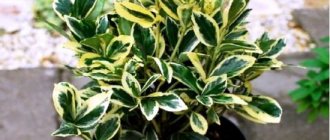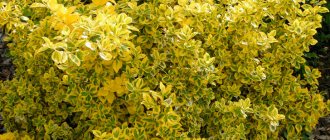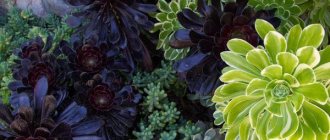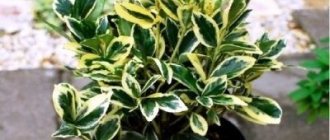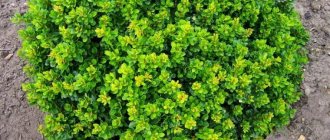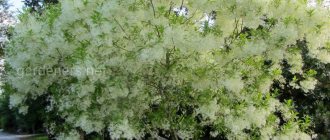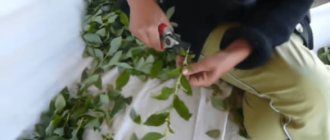Description: varieties and varieties of euonymus Fortune
In nature, Fortune's euonymus is a creeping evergreen shrub up to 30 cm high. But if you prepare a support for the shoots - a wall or trellis - it will grow vertically and can reach a height of even 2 m. Characteristics of the shrub:
- leaves - oblong, oval;
- the color of the leaf blades is two-color, with a pronounced transition line between tones: rich and light green in spring, rich red and pink in autumn;
- The flowers are small and have a large seed box.
Attention! In the middle zone, euonymus rarely blooms. The main value of this plant is in the bizarre and changeable patterns of foliage, which looks great in person or in photos.
Fortune's euonymus comes from China. The culture has more than 220 species. The most popular in landscape design are:
- Emerald Gold. The leaves have a characteristic golden border, which looks most beautiful on young greenery. More often used in vertical decoration. Loves the sun and withstands slight frosts.
Variety Emerald Gold - Emerald Haiti. As a ground cover plant, it grows into an elegant wavy carpet no higher than 30 cm. Frost resistance is lower than that of Emerald Gold.
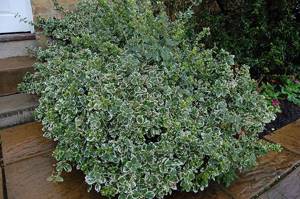
Emerald Haiti - Harlequin. Used in creeping form. The foliage is white, with cream, lemon and pink streaks. Tolerates sun deficiency well. At minimal frosts it dies.
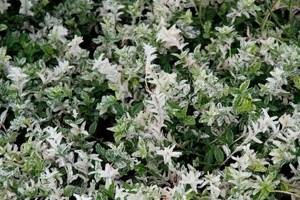
Harlequin
Description of euonymus
This is a whole class of plants, which has over 200 species. Habitat: the entire Eurasian continent. On the territory of Russia, the cultivation of 10% of predominantly artisanal varieties has been mastered. But in nature there are also entire trees more than 3 m high. Some of them are in danger of extinction due to their inability to cope with human activity.
Here's just a quick overview of some evergreen and deciduous varieties:
European - a cold-resistant tree up to 6 m high. The species of this euonymus is a shrub. Resistant not only to frost, but also to drought and gas pollution in cities. In the garden culture of European countries it forms a hedge. It is divided into several subspecies: weeping, dwarf, etc. They differ in the color of the leaves and the size of the bush. Small-leaved is available in the exhibitions of botanical gardens around the world, including Nikitsky in Yalta;
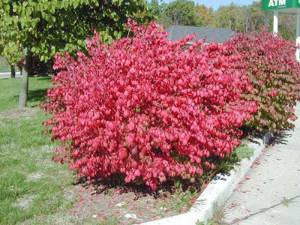
Luxurious euonymus sacred to many nations
- winged is found mainly in Southeast Asia. It also took root in Russia, on Sakhalin. It got its name from the similarity of its branches to wings. The plant is impressive in its size: the tree or shrub does not exceed 4 m in height. It has high winter hardiness, but in severe frosty winters the tips of the branches freeze and require pruning in the spring. It is unpretentious to the landing site, but prefers the most illuminated areas. Planting and caring for this variety of euonymus in the Urals is impossible;
- Fortune. Until recently, the species was considered endemic. It grows in the south and northwest China. Fortune is noticeably different from its peers. It is winter-hardy; in nature, the creeping euonymus in winter is covered with a ball of snow. It tolerates pruning and transportation well. Fortune Emerald Gold is one of the varieties of euonymus for planting and care in the regions of Siberia and the Urals.
The variegated euonymus completes the selection. His homeland is sunny Japan. Growing will be a pleasure and will not take much time. It has taken root very well in Russia, especially in the Siberian region. Breeders have bred more than fifty varieties up to 7 m high. The plant feels great in open ground and indoors.
For your information! The only exception is pseudolaurel, which grows exclusively in greenhouse conditions and does not tolerate low temperatures.
Some types of euonymus - creeping or variegated - are striking in their diversity. The designs and shapes of flowers change. The color of the leaves is predominantly green and red.
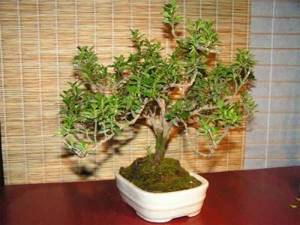
Euonymus in a container
Planting a plant: methods
In cool climates, the only effective way to plant Fortune's euonymus is ready-made seedlings. The best time for propagation in open ground is from the second half of April and throughout the month. Some gardeners practice autumn planting, but this growing method is more troublesome. It is better to plant dwarf varieties in containers and bring them indoors for the winter.
The culture loves a neutral soil composition. Acidic soil is contraindicated for it. The soil should be light, loose and nutritious. The degree of illumination required depends on the variety. Most of them prefer afternoon partial shade. Spotted varieties prefer plenty of sun.
Attention! Keep in mind that in open ground the euonymus will quickly grow in width.
Having chosen a suitable place on the site, dig a hole. It is important to do this a couple of weeks before planting. The dimensions of the hole are 2 times the size of the rhizome:
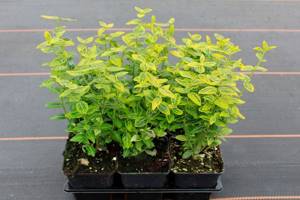
Euonymus seedlings
- Place a layer of sand at the bottom. Mix the removed soil with compost and complex mineral fertilizer.
- Place the seedling in the center of the hole. Bury with prepared soil.
- Lightly compact the planting area. Water deeply. Shade the seedling for the first time. Mulching works well.
Advice. To make a hedge from Fortune's berselet, plant the plants in trenches.
Euonymus - planting and care
Being an unpretentious plant, it is ideal for cultivation at home or in the garden. Growing perennials in open ground is quite simple. Planting is carried out in spring in light and fertile soil with good water permeability. Green-leaved perennials should be placed in light partial shade, while variegated varieties, on the contrary, prefer brightly lit areas.
Video - euonymus care, planting and reproduction.
When caring for it, it is necessary to regularly water it as the soil dries out, mulch the soil near the trunk, feed it with mineral fertilizers in spring and summer, and regularly prune it, improving the decorative properties of the plant.
Formative pruning should be done in early spring, or immediately after fruiting. Also, at the stage of active vegetation, euonymus requires partial sanitary thinning. Before wintering, young bushes must be protected in the first couple of years after planting. Most often, dry leaves are used for this.
Shrub care: features
In open ground the plant does not require attention. Caring for it can be reduced to performing simple manipulations:
- Shrubs need watering only when the top layer of soil is dry. If in summer it rains at least once every 2 weeks, you don’t have to worry about watering at all.
- Mulch will help retain moisture. Use pine sawdust.
- Pruning will help you shape the bush into what you want. You can even make a standard type plant.
- Immediately after planting, the shrub needs regular loosening and weeding. Weeds can harm young seedlings. Loosening is best done 3-4 days after irrigation.
Advice. For the winter, annual shrubs of some varieties should be covered. Gardeners make a mound of dry leaves up to 20 cm in height. Ideal conditions and frost protection for euonymus are natural snow cover in a windless area.
Features of caring for euonymus in the garden
Planting and replanting euonymus in spring
Before planting euonymus in open ground, you need to choose a place where the plant will develop well. The culture loves sheltered from the wind, sunny positions or light partial shade; variegated varieties especially need bright sun. In the shade, euonymus grows poorly, and its bright foliage color fades.
The optimal time for transplanting euonymus is spring or mid-October, and planting with a closed root system can be carried out throughout the season.
Also consider the size of the plantings. Some varietal forms grow strongly and leave about 1.5-2 meters between them or other crops.
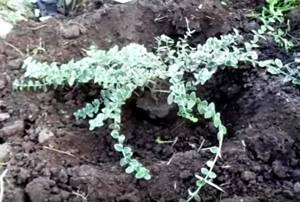
Choose a place for planting euonymus with low groundwater levels. The plant needs a fertile, permeable, slightly alkaline or neutral acidity substrate. The soil from the prepared pit is mixed with three parts of compost. As drainage, a layer of large expanded clay or broken brick is laid at the bottom of the pit.
All about the rules for preparing compost from various natural materials can be found in this article
However, if the soil on the site is not clayey and contains sand, then drainage is not necessary. A small layer of prepared soil is poured on top of the drainage and the plant is placed in the hole. Its size should be slightly larger than the root system.
The root collar of the bush should be at ground level. After filling the hole, the soil is compacted well and watered abundantly.
Unlike dwarf forms, large species and varieties of euonymus can only be replanted at a young age. Replant together with a lump of earth so as not to injure the roots of the plant.
It is recommended to mulch the soil around the plantings with tree bark or wood chips. Mulch plays an important role in caring for euonymus in the garden - it maintains soil moisture, controls the growth of weeds, prevents overheating of the roots and the development of fungal diseases, especially in groundcover species.
Fertilizer and fertilizing Fortune
In addition to care activities, the plant can sometimes be fed. This will help:
- give splendor to the bush;
- make greens brighter and richer.
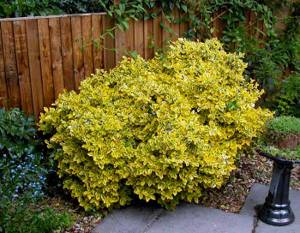
The frequency of fertilization is 2 times a season. In the spring, in April-May, compost and a mineral complex are usually added. In autumn - mixtures with potassium and phosphorus. Humus and compost also work well as fertilizers for shallow digging in the first months of growth of a young bush.
Plant propagation: options
Growing euonymus in the middle zone rarely results in flowering and seed formation. For propagation, gardeners use simpler and more effective methods:
- Cuttings. Select an adult plant that is at least 5 years old. At the end of June, cut the shoots into cuttings 6-8 cm long with at least one internode. Plant immediately under the film, in nutritious and loose soil. Place a layer of sand about 3 cm on top of the soil. With proper care, the cutting will take about 1.5 months to root. Afterwards, it immediately needs planting in open ground.
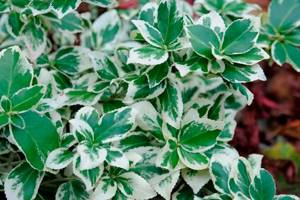
Plants older than 5 years are suitable for propagation by cuttings.
- Root suckers. Planting material should be cut before the plant awakens, during the first thaw of spring. Shoot length is 40-50 cm. Root length is 20-30 cm, thickness is no more than 1.5 cm. An earthen lump should remain on the root. The shoots can be planted directly into the garden bed or grown into a full-fledged seedling.
- Shrub division. A good way to propagate dwarf varieties. The plant itself forms young shoots on the main rhizome. It is important to separate it carefully. Before planting, cut the divisions by 2/3.
Varieties
It is interesting that many varieties of euonymus “Fortune” change the color of their foliage with the onset of cold weather. If in summer shrubs of almost all varieties are green, then by autumn they turn red, yellow or pink.
- Fortune's euonymus "Emarald Gold" . Compact plant up to 40 cm high with elliptical leaves, the middle is gray-green or marbled. The edges are decorated with a lemon yellow or light yellow border; by autumn they acquire a bright pink hue. Quite common in Russia, can withstand temperatures down to -25 degrees without snow.
- " Emerald Gaiety" A variety of euonymus with dark green leaves and a white border; they turn pink in autumn. This variety is widely used in landscape design.
- "Silver Queen" The shrub reaches a height of up to 20 cm and grows up to 1.5 meters. The leaves are bright green in summer and turn pink in autumn.
- SunSpot . Similar to indoor Japanese euonymus, it hardly grows. It reaches a height of 20 cm, the leaves are 52 cm long. There is a bright golden spot along the axial vein. This variety tolerates frost well.
- "Harlequin" (EuonymusHarlequin). It is an evergreen and dwarf shrub with white-variegated leaves, its branches spreading along the ground. If the leaves are constantly exposed to the sun, they eventually fade and become pale and may dry out. Experienced gardeners advise planting the euonymus "Harlequin" in semi-shaded places. The plant will decorate a small garden, any landscape and urban composition.
- "Coloratus" . A shrub with bright green leaves that turn purple in autumn.
- " Canadale Gold" A small shrub with shiny yellow-edged leaves.
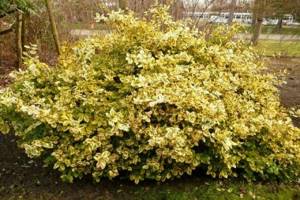
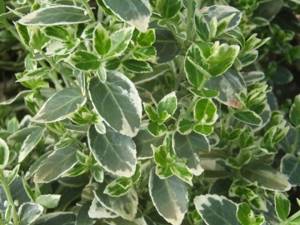
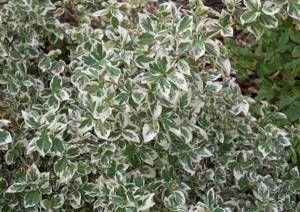
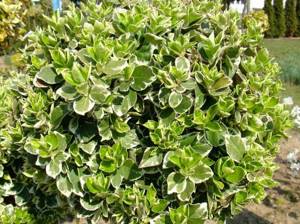
Photo: euonymus fortune Harlequin.
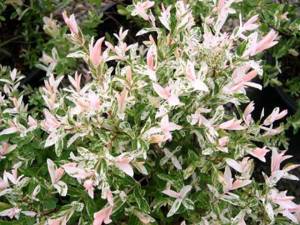
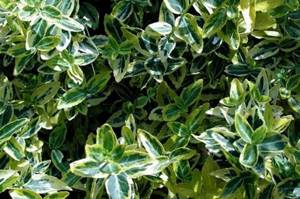

Decorative viburnum Buldenezh. Read about this shrub here. And here is an article about winged euonymus.
This section of our website is all about alpine slides and rockeries.
Diseases and pests of euonymus
Some parts of the plant are toxic, so the euonymus itself protects itself from most pests and fungal infections. Sometimes spider mites appear on the bush. The leaves curl and fall off. Prevention will help get rid of tick reproduction:
- in the spring, spray the greens once with colloidal sulfur;
- In summer, treat the shrub with specialized insecticides.
Much less often, a plant, usually in a neglected state, can be attacked by scale insects, aphids and some fungal viruses. The fight against them is similar, only the preparations may differ due to the specifics of the pests.

Euonymus goes well with conifers
Popular varieties and types of euonymus with photos
Winged euonymus (Euonymus alatus) . The most important decorative element of this species is the fiery color of the autumn foliage, for which the plant received another name “burning bush” or “burning bush”.
It is a slow-growing, dense and wide shrub up to 2 m in height with rigid, highly branched, brown or greenish straight shoots.
The surface of the shoots is covered with longitudinal, ribbed, corky growths resembling wings, which is why the plant received the name “winged”. During the summer, the leaves remain green, and in early September, literally within a week, they become intensely scarlet. It seems that there is a fire bush blazing in the garden.
Variety "Compact"
The flowers have no decorative value, but the fruit stems are purple-red, standing out brightly on the bare shoots with the arrival of winter.
“Compact” is the most famous variety of this species with a rounded compact crown and a height of up to 1 meter. Its leaves change color to different shades of red in autumn.
“Fireball” - multi-colored autumn foliage, the height of the variety is about 1.5 meters, the crown is spherical, compact.
"Rudi Haag" - an extremely low, dwarf variety, up to 0.6-1 m high, with wider “wings” on the shoots and very slow growth.
European euonymus or bruslin (Euonymus europaeus) . It is a tree in the form of a tall bush. The leaves are dark green, and there are also variegated varieties. In autumn they change color to bright red.
Although this species is not widespread in gardens, it certainly deserves more attention due to its very decorative bright pink or red fruits and colorful autumn foliage.
The most famous variety, “Red Cascade,” owes its name to the leaves, which turn crimson with the onset of autumn.
Fortune's euonymus (Euonymus fortunei) . Probably the most decorative and widely cultivated evergreen ground cover species with a huge number of varietal forms and varieties.
Caring for Fortune's euonymus is slightly different from other garden species, mainly due to its growth form, which is characterized by creeping shoots with shiny, leathery leaves.
Popular varieties and varieties differ in foliage color and height. Let's list the most interesting of them.
"Emerald'n'Gold" (Emerald and gold). A bright, low-growing bush that is often used in garden landscaping. In cold winters, the golden-emerald leaves take on a pinkish tint.
'Emerald Gaiety' is a wide bush with dark green leaves and a wide white edge.
"Sunspot". A small bush up to 30 cm in height with shoots that spread along the ground, forming an attractive yellow-green carpet. The leaves are green with a bright yellow or cream spot in the middle of the leaf. In winter they take on a red tint. Does not require any pruning.
'Harlequin' is a compact, slow-growing shrub with variegated green and creamy white leaves that turn pink in autumn.
"Sunshine" is a shrub up to 70 cm in height and up to a meter in width. Bright yellow leaves with a green center. It lends itself well to pruning, which allows you to form a compact, rounded crown.
'Silver Queen' is a popular and highly decorative form with variegated white and green foliage. Its long shoots, reaching 6 meters, can easily trail along the support.
"Silverstone" is a beautiful dwarf shrub 30 cm tall with semi-erect shoots and green-white spotted leaves.
Japanese euonymus . Mainly cultivated as a houseplant. It is characterized by narrow, leathery leaves that can reach 7 cm. The shrub is sensitive to cold and requires protection in winter.
“Microphyllus” is very similar in appearance to boxwood and is also easy to form a crown.
'Bravo' has green and creamy yellow variegated leaves. 'Golden Queen' with broad golden-yellow foliage. "Katie" with variegated white and green leaves.
Variety "Silver King" with a compact crown and variegated green and white foliage.
"Aureomarginata" is a variegated variety with green leaves and a white-yellow border along the edges of the leaf.
Euonymus Fortune: combination with other plants
This culture is universal in the garden. Depending on the variety and pruning method, Euonymus can decorate a rocky landscape, border, flower bed or parterre. Where winters are not too frosty, the plant becomes a vine on the wall of the house in the manner of ivy. Gardeners often choose the appropriate variety simply based on a photo that reflects the color scheme of the plant.
Euonymus is suitable for combination with almost all inhabitants of flower beds. For example, in topiary, mixborders. In open ground, combinations with conifers and other ornamental shrubs are used. The crop is also successfully grown in outdoor containers.
Fortune's euonymus will help you quickly and brightly landscape your area. Growing and caring for this plant is simple, and the options for using its decorative properties are extensive. This is why the culture is loved in many countries.
Reproduction of Fortune's euonymus
There are several ways to propagate Fortune's euonymus on your site:
- Cuttings
. The most effective and popular method. Fortune's euonymus, propagated by cuttings in the summer months, takes root and manages to grow stronger in fertile soils in pots until next spring. With this method, young, non-lignified shoots about 10 cm long are selected. After cutting, they are kept for about 12 hours in any root-forming solution, for example, “Kornevin”. Then they are planted in pots with fertile soil, moistened with a spray bottle and covered with film. After 2-3 weeks, the shelter is removed, and the seedling remains in the greenhouse or house until spring. - By layering
. The selected lower branch is fixed with a bracket and sprinkled with earth. The layering site requires systematic moistening. After rooting, the young shoot can be planted in a permanent place. - Dividing the bush
. Mature shrubs can be planted by dividing the root system. To do this, the euonymus is dug up, the roots are divided into several parts, each of which should contain a growth point and several shoots. New shrubs are planted in permanent places. - Planting seeds
is possible in the spring months in open ground or in winter in pots with a mixture of turf soil and sand in equal proportions. After 3 months Shoots appear, which after a month of growing in pots can be planted in the ground.
